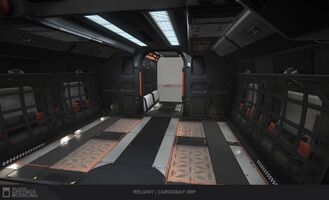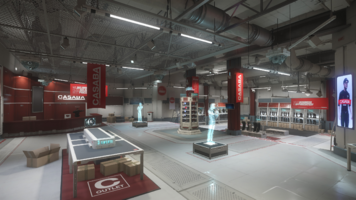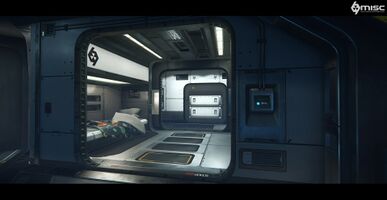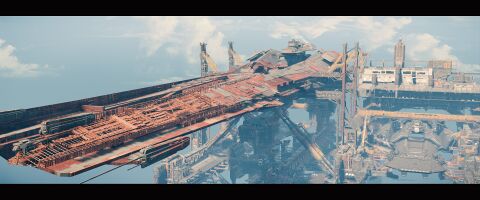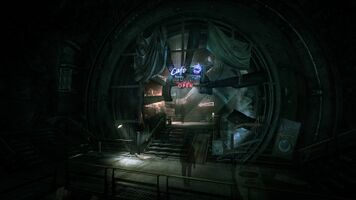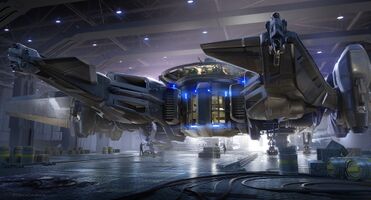Greetings Citizens,
What a month! It’s likely that many of you know exactly what we were working on, as we’ve been publishing updates to Star Citizen Alpha 2.0 on the PTU as quickly and as quickly as possible. As you’ve observed, your testing and feedback has allowed us to zero in faster on the various bugs that were preventing us from going live. We’re pleased to announce that as of today (December 11, 2015) Star Citizen Alpha 2.0 is available live! But before you start exploring Crusader, let’s look back at what we did in November.
We’d also like to invite you to tune in on Wednesday, December 16th at 11 AM PST for our annual Holiday livestream. We have some exciting content we’re looking forward to sharing with everyone before our teams enjoy some hard-earned time off for the holidays. Tune in and help us round out a great year!
CIG LOS ANGELES
Hi all!
November turned out to be such an amazing month for us here in LA (as well as the entire company). We knocked out huge milestones to help bring 2.0.0 to the PTU all while moving into a bigger and better space that’s conducive to improved communication and more efficient work practices. The level of finalized work has helped us put the month of November on the map here in CIG LA. Below is the in-depth breakdown of what we accomplished. Enjoy!
Engineering
Creating a true multi-crew universe in Star Citizen is a seriously daunting and ambitious goal. The Los Angeles Engineering group is incredibly proud of their accomplishments in creating a unique gameplay environment with unprecedented potential. Associate Gameplay Engineer Chad Zamzow and Gameplay Engineer Mark Abent are the individuals individual behind the programming of our new EMP weapon, implementing the various effects the EMP weapon will have on its targets plus smashing any bugs that arose.
Server stability is always a major priority for our Engineers, and our engineering team has been one of the groups responsible for the markedly increased performance of the 2.0.0 PTU servers over the past couple weeks. Not only has the team been working on reducing server crashes, they’ve has also been integrating the new ItemSystem 2.0 code into the development code branches for future releases after 2.0.0. They have has also been working with other coders on the ItemSystem 2.0.
With a sharp eye towards improving the flight dynamics in-game, our flight engineers have been fine-tuned the new Flight Modes to our IFCS, allowing players finer control over their ships at differing velocities. While not directly game-related, we have built a tool called the Loadout Editor. This powerful tool makes it far more efficient and convenient for our Designers to directly edit the loadout of the Vehicles, Items, and Characters, instead of the error-prone practice of manually editing the XML files separately. This providing our designers with greater ability to focus on design with less potential worries.
Design
If anything can be said about the Los Angeles (formerly Santa Monica) Tech Design Team, it is that they are an endless wellspring of innovation and creativity. The excitement of having pushed 2.0.0 to the PTU is a massively important milestone for Star Citizen. Allowing our players to captain ships with other players in a multi-crew environment is one of the keystones that the vision of Star Citizen is hinged upon.



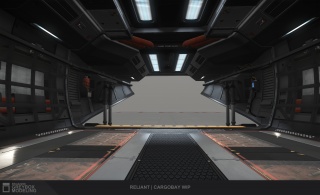
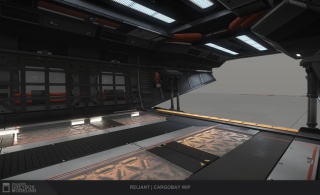

The LA Tech design team achieved milestones that are as awesome as they are astronomical. One of the most anticipated ships in the game, the Constellation, has been their responsibility for finishing the tech setup of the ship and getting it out into our backer’s hands in the 2.0.0 release. Designers have retro-fit many of the legacy ships to utilize the new component system that he’s been efforting. So far, the 300-series, the M50, Avenger, and Gladius have been retro-fit as of this update.
That’s not all: they have also been diligently designing the Salvage mechanic and has been working hand in hand with our Design Director. The Repair mechanic has also passed its next step in the design process as we inch closer to sharing how these features will work with the Anvil Crucible ship.
The first implementation of the EMP system is running through the final tests with our QA team giving it a shakedown ensuring it will be as effective as it is stunning when directed at your enemies. Furthermore, we have been fine-tuning how exactly the EMP weapon will affect its targets; from causing screen corruption on the HUD to causing distortion damage to the pipes, the EMP system on the Warlock Avenger is a feature we are excited to debut.
Art
Now that players are able to disembark from their ships and explore the various sites in Star Citizen such as the Crusader space station, our artists are putting their styluses into heavy gear to create a beautiful, living, breathing universe. Our character concept artists have penned the concepts for a variety of uniforms and armor in the universe. Most recently, their skills have been bent towards designing a unique style for the UEE Marines from the Light Armor to Medium Armor and even how the Marine under suit will look and feel. One of our artists even had the envious responsibility of creating the game assets for Mark Hamill’s Steve “Old Man” Colton’s space suit.
Within the Star Citizen universe, we have designed each vehicle manufacturer to have its own unique design language. This not only allows each ship to possess a recognizable silhouette, it also maintains a level of consistency for each manufacturer’s brand image. The concept art team has helped create style guides for the vehicle manufacturers within Star Citizen, much as your favorite brands of automobile manufacturers do in the real world. This internal consistency of manufacturer styles is apparent in various ships such as the AEGS Gladius and AEGS Retaliator, making each brand more distinctly recognizable. They’ve also completed the elegant concepts for the Archimedes.
Speaking of ship designs, the MISC Reliant single-pilot ship incorporates alien Xi’An technology, so the art stylization of the Reliant needs some additional aesthetic cues while still reflecting MISC’s distinct design language. Our artists and rigger have grey-boxed the MISC Reliant, moving it out of the concept art stages and bringing it that much closer to becoming flyable. The milestones that have been crossed are the modeling of the cockpit, cargo area, and exterior tail. The Drake Caterpillar has reentered the concept stages for further exploration to help catapult that into production soon.
Writing
For the PU, the writign team has been juggling a handful of different areas. In addition to combing through the old Galactic Guides to bring them more in line with the Starmap, they’ve been delving back into landing zones, working on fleshing out the locations themselves as well as the characters who inhabit them. Writers have been organizing the clothing system by determining an initial batch of styles and manufacturers to make it feel really robust, versatile and (most importantly) expandable.
For Squadron 42, they’ve just finished a complete review of all the sequences from Chris’ selects sessions last month. In a nutshell, the process is effectively sitting and watching each of the edits side by side with the script to confirm what’s been shot/edited and what hasn’t. Tremendously exciting stuff, I know, but with all these scenes, characters and files flying around, it’s very easy for things to slip through the cracks, so this is a helpful check to make sure that doesn’t happen. It’s also being done to understand what would be needed if additional shoots are required.
Finally, we’ve just been playtesting the 2.0 PTU demo which has been really amazing to see come to life this month.
There we go! November wraps up with some top-notch work from a dedicated team willing to do what it takes to deliver the best game possible. We’re bringing a close on several major developments for Star Citizen and we’re excited to share with you. We greatly appreciate the trust you’ve put in us to make the game you (and we) have always dreamed of. Until next month.
CIG AUSTIN
Greetings Citizens,
November has been a full month with many great moments. We’ve been testing 2.0.0 internally for some time and now we have allowed (at the time this was written) more than 125,000 accounts to help us test 2.0.0 on the Public Test Universe! We had a great Live Stream from the LA studio mid-month, and had a very successful AnniVERSEary sale and celebration. Here are detailed reports from each team in the Austin studio!
Persistent Universe Team

With Thanksgiving on the brain this month, the Persistent Universe team in Austin has had their hands in all kinds of pies! The Art Team have been focused on several different environments. Cort Soest spent a lot of time drilling down on performance optimization for the Crusader map for release in 2.0.0, trying to get it to run as smoothly as possible. Lee Amarakoon and Emre Switzer also took the Nyx>Delamar>Levski landing zone environment that BHVR has been working on and gave it a first pass on VFX and Lighting. While it’s not in 2.0, that environment is in Final Art Polish phase and we’re rounding out the finishing touches. The Casaba Outlet clothing shop has also received a polish pass, and lighting for that environment has wrapped up as well. Lastly, concept artists Ken Fairclough and Ted Beargeon have been helping develop some look/feel concepts for the [REDACTED] environment for Squadron 42.
Our concept team has also been hard at work developing a gigantic Star Map poster to be included in physical and digital version of game packages, at which point you’ll be able to see all the crazy detail that has gone into this painting. We’re highlighting some of the near-term landing zones and…well you guys will just have to wait and see the rest!
Our Animation Team has had their hands full as well, and not just with turkey legs! We’ve been retargeting male animations to the female skeleton in preparation for her release. The female character can now enter, exit, and interact with all of our ships thanks to initial implementation by Jay Brushwood. We still need to do a polish pass on those animations but we’re getting there. We’ve also gotten the female locomotion set running smoothly (no pun intended) except for a few hiccups that need ironing out. Bryan Brewer is working on ironing those out with the help of Sean Tracy. We’re looking ahead to our NPC AI release, and Vanessa Landeros and David Peng are implementing Medical Unit and Nightclub animations, respectively, so our NPC’s will be a little more lively out in the PU. Lastly, we’ve had our hands on several ships prepping them for launch. We tackled the character interaction animations for Avenger variants earlier this month and are now focused on the Vanguard, Freelancer, and Xi’an Scout.
On the Design side, we’ve wrapped up creating blueprint documents for the shops on Levski (including the bazaar area). We now know what exactly is going to be sold in the shops on Levski, and have added these items to our Shop Inventory Matrix. We’ve also identified props, characters, and gameplay functionality required for these environments and are now mapping out a plan of action for these assets and features. We’ve been looking ahead towards future landing zones and points of interest for the Stanton system recently, trying to flesh out the “in-between” space amongst the major hubs of Hurston, MicroTech, Crusader, and ArcCorp.
Tony Zurovec has been up to his eyeballs in all kinds of design discussions around the company. Topics discussed include Shopping, Character Customization, Persistence, Remote Storage, Jump Point travel, Exploration, and Mission Types. Some of these are pretty near term and you should be able to see the fruits of these discussions fairly soon. Others are longer term but on our radar nonetheless. Those who have been paying close attention will likely be able to distinguish which features are which!
On the Programming front, Jeff Zhu wrapped up work on the brand-spankin’ new Main Menu. Now that we have Crusader as a locale option, we thought it was important to allow you guys to jump right into the action wherever you choose. Getting where you want to go as quickly as possible should be much easier now thanks to this new feature. Much of the rest of the month has been spent on fixing bugs found in the Party System since we want this feature to be as clean as possible for our next release.
Work on Persistence continues to plug away on the backend. Jason Ely, Tom Sawyer, and Jeff Zhu are all contributing to this work and we’re hoping this team effort will allow us to be able to show something more front facing here in the near-future. Our first goal is to get Character Customization and Shopping persisting across gameplay sessions.
Live Operations
QA
QA has been very productive for the month of November. The month began with QA well into SC Alpha 2.0.0 testing. The team conducted daily playtests and promptly reported all issues to production. With each passing day and more fixes, we were able to witness the game slowly evolving into a very fun experience!
We could see the potential but the game was still suffering from multiple serious issues including server and client crashes that hindered game play significantly. Although SC Alpha 2.0.0 was far from being ready to release officially to our live environment the decision was made to deploy to the PTU to a small group of backers. This proved to be incredibly valuable. A big thank you to these dedicated backers for suffering through these issues to help us test the initial PTU deploy.
Going forward we will look to the PTU as a true test environment. More builds will be deployed in earlier states so we can begin testing features with larger numbers of people and start implementing fixes as early as possible. So keep in mind that testing on the PTU will not be for the faint of heart, nor for the selfish of spirit. PTU is neither Alpha nor a pure privilege – it is participatory QA, and a PTU tester’s job is to help us identify and nail down problems that are keeping the release from the rest of the backer population.
After multiple fixes and seven daily deployments to the PTU the game is much more stable. As of this writing we still have a few must fix issues but are well on track to officially releasing SC Alpha 2.0.0 to our live environment very soon.
Everyone on the QA team is doing an amazing job. Our newest addition QA Lead Vincent Sinatra has settled into his role in the LA studio. Vincent wrote up a comprehensive report comparing each ship’s flight behavior between SC Alpha 1.3.0 and SC Alpha 2.0.0. With this information our Technical Designers were able to tune flight behavior for SC Alpha 2.0.0 to their intended specifications. Vincent is also working very closely with our ship expert and Austin QA Lead Andrew Hesse testing the new IFCS modes as well as providing valuable ship balance feedback.
On the Automated testing front Melissa Estrada has been continuing to work very closely with Engineer Miles Lee and Global Environment Tech Lead Cort Soest. We are now able to fully automate our various editor tests. This will be incredibly helpful to ensure any issue that would hinder development is reported and fixed as soon as possible.
Jeffrey Pease has been amazingly helpful this past month. He has taken on the colossal task of monitoring our game servers and back end services during a very challenging phase. Each day Jeffrey combs the server logs and provide comprehensive reports and metrics to our producers and engineers. This information has been integral in their efforts to stabilize the servers during our initial deployment of SC Alpha 2.0.0 to the PTU.
Todd Raffray has been heading up testing of our party system, chat and Area18. Robert Gaither has been assisting Todd and also each day compiling and providing an updated SC Alpha 2.0.0 must-fix issues list to production. Andrew Rexroth has been ensuring all FPS related features and issues are continually tested. Marissa Meissner has been compiling patch notes and known issues, verifying each reported fix, and documenting best practices. Tyler Witkin travelled to LA to help train Vincent and also conducted workshops with the LA designers and engineers to ensure they know how to obtain and play the latest builds QA is testing. Besides their individual areas of expertise, everyone is also working together heavily testing Crusader.
This has been a very busy month, but all of our hard work is paying off with how SC Alpha 2.0.0 is shaping up. We are very much enjoying watching and reading about everyone’s experiences. The excitement is palpable! The team is doing great and we are incredibly excited to share SC Alpha 2.0.0 with everyone! See you next month!
Game Support
November was a pretty big month for Game Support for a few reasons, not the least of which is because we’ve doubled our staff size. That’s right, everyone… we’ve gone from one to two! ?
Will Leverett in Austin, Texas has been joined by Chris Danks at Foundry 42 in Manchester, UK. Chris comes to us not only with a wealth of technical knowledge and support experience, but he is also a backer! Chris has started recently and is already hard at work, and we’re excited that we now have a presence in both Europe and in North America that allows us to expand the hours of coverage for players.
Aside from this, our biggest news is obviously related to 2.0 on PTU. Part of Game Support’s mission is to assist in managing playtests, coordinating with Production, QA, and LiveOps. Getting 2.0 on PTU is a massive step forward for Star Citizen, and we’ve been very excited to help construct the mechanisms that allow players to test and contribute back to the game’s development.
To prepare for the coordination of testers, we’ve set up a special PTU Issue Council plus a Discord chat server so that testers can chat and test together. We’re also collecting information to push out notifications and updates to our forums, to Reddit, and to Discord. Different players like different mediums, so we want to hit everywhere that our players congregate.
This has easily been our best testing period yet. We’re excited to do our part to help make the BDSSE, and we can’t wait to get 2.0 out to everyone else as soon as it’s ready!
IT/Operations
Our big project for this month was the complete relocation of the LA studio. Dennis Daniel, our IT Manager in LA, has been working tirelessly preparing the new office for this move, from overseeing the network wiring installations to coordinating with contractors on every level ensuring that the server room meets standards including fire safety, physical security and access controls to name just a few prep items. During the move itself, Dennis personally handled most of the system tear down and packing as well setting up and testing every single developer workstation in the new location.
This type of physical move affects the entire network and can disrupt secure communications between studios. In order to reduce downtime for the dev team the move was effected over the weekend and continued around the clock so developers could start work first thing Monday morning. Paul Vaden, Network Services Manager and Mike Jones, IT Director came out from the Austin studio to help migrate back end infrastructure while our system engineers, Mike Pickett and Chris Graves provided network programming support remotely from Austin. Due to the extensive prep work and planning, the LA studio was only disconnected from the rest of the company for 1 hour while the servers were physically transported from the old location to the new server room and reconnected. IP ranges were not migrated so it was necessary to change all the firewalls and tunnels from Austin. Mike and Paul installed network upgrades and secure communications between studios were restored quickly and after a few hours of testing, monitoring services were restored well within the planned outage window.
The new studio looks amazing and thanks to the extra planning during construction, we were able to include several other upgrades for the team including greatly improved storage performance, wireless networking, and a revamped phone system. Sometimes the small things really matter and cable management falls in to this category. Development areas have only two wires per workstation coming down to floor pockets, making for very clean cabling. The server room received new racks and cable management making the new LA server room a showpiece _that is, for the very few people who will ever get past the new multi-tiered security systems locking down the studio’s central network.
Live Ops
The publishing team has spent considerable time this month on improving publishing efficiency and reducing downtimes specifically within the PTU. We’ve accomplished reduced deployment times again as well as internal reporting on server load and health. Star Citizens helping us test the PTU will have noticed numerous back to back publishes this month as well as dramatic improvements in client and server stability based largely on their help and these new reporting stats. We’ve also significantly increased the number of servers supporting the PTU cluster as part of our continued load testing scope. The information provided in these tests has been invaluable to the dev teams and we plan to keep this type of testing going for the foreseeable future. We expect this will lead to a much more predictable publishing cycle on the production servers.
FOUNDRY 42 UK
Greetings Citizens,
Another busy month on Star Citizen! We have a lot to celebrate as the year draws to a close, and there’s a lot coming down the pipeline to share with our backers. Here’s our department-by-department breakdown of what was accomplished this month, as we march onward towards Squadron 42 and close out the year with Star Citizen Alpha 2.0!
Animation
This month we’ve been working closely with the animation director and programmers with the view to getting the locomotion sets, lookposes, stop starts, reloads, weapon select and deselects up to shape for the FPS portion of the game.
We’re also still looking to recruit a few more members to the team to handle the work load next year.
Graphics
This month has all been about getting 2.0 into the backers hands, and a lot of work has gone in behind the scenes to improve the underlying tech to make this release possible, but unfortunately the details aren’t as interesting as our usual graphics work! We’ve been crunching through dozens of bugs including Crossfire/SLI issues, light & LOD ‘popping’, shadow ‘peter panning’ and shadow ‘acne’ among many many others.
Other than bug fixing our other major focus this month has been on performance. The 2.0 release threw up a LOT of performance issues due to the scale of the map and the amount of content the design team are pushing in, and so our team helped the rest of the studio diagnose and fix these issues. Most of the performance issues were with the CPU and not the GPU, and so that’s where our focus has been, and after several weeks of optimising we got the base frame-rate up from 20 fps to above 60 fps. Many of these were ‘easy fixes’ where the game was processing a lot more objects/lights/whatever than it need to (easy to happen with such a large complex map!), and after improving the logic and/or culling algorithms we were able to vastly improve the performance. Unfortunately not all the performance issues were so easy to address, especially those relating to increase the number of ships in the levels, and so there’s now a few bigger improvements in the works from the game and core-tech teams that will greatly improve the performance in later releases but couldn’t be completed in time for 2.0. As we continue to resolve the CPU performance issues the bottleneck will then likely move towards the GPU and this is what we’ll need to focus on for the next few releases. On a related note we’ve noticed that a lot of our keen backers are tweaking their user.cfg file to change a lot of rendering settings to squeeze some extra performance out, but not always in the best way. So in a future release we’ll hopefully write a quick guide as to what exactly these settings do and how you can set them up to get either the best visuals or performance.
Engineering
Again this month we’re beavering away working towards the 2.0.0 live release. Our first main concern has been trying to get stability sorted, followed by performance, and then general bug fixing. Because this is such a big release with so many new features and new technology this has been quite a big challenge, especially when we start stressing all the systems getting more and more players in. For example one the big issues we had before we could get the build out to the PTU was that spawning in the big ships, such as the Retaliator or the Connie, would immediately cause everybody to disconnect with a network error. Not great for a release designed to bring multicrew gameplay out to the public! Because the standard CryEngine assumes everything is loaded at the start of a level, and doesn’t expect entities to be spawned in dynamically, we were fighting some of the network code to behave with how these larger ships are built. Finally after much head scratching a solution was found, and now it’s up on the PTU and so far it seems to have had a really positive reception, with people really having fun out there. There are still a few nasty bugs showing up, both on the clients and the server, which we’re hammering away at before we can get it to go live.
In the meantime… on the UI side. We’ve been working on a couple of new applications for Mobiglass. Firstly there’s the new mission viewer app. This allows you to track what missions you’ve received, which are currently active, and which have been completed. Similarly for the active missions you can then drill down and see what objectives they currently consist of, which you’ve completed and which are currently active. All active objectives can have HUD navigation markers so you can tell where you next need to go. The other app is another system to track all the information you’ve collected on your travels. As you go through the game you’ll be required to find information to help you complete your missions. This information can be uploaded to your Mobiglass as you go along, and this can be just from some interesting text, to images or audio and video clips. The app will allow you to browse and organise everything you’ve collected for future reference. Other UI work includes an ongoing optimisation pass, as it can get surprisingly expensive, especially when they’ve been initially prototyped and implemented in ActionScript.
Work is also continuing on the changes for the new component system, which again will help make the update of the entities more efficient in the longer term, and moving all the old GameobjectExtensions over to the new components. This is a pretty big change, and no doubt will cause some new issues, but it will in the long run mean more robust and faster code.
QA
At the risk of re-treading what the other departments may have already said in their updates, November has been all about working hard to get the next iteration of Star Citizen to the public; in other words, the push of 2.0.0 to the PTU and eventually to Live. However, for the UK QA team, the long hours were quickly forgotten as soon as we started to get our first glimpses of the Largeworld map being played by the backers. It’s really been a great reward to see all the examples of emergent gameplay we knew were possible (and which the constant test cases kept us away from!). It’s like they always say, a PTU Largeworld Star Citizen patch is as good as a rest. Thankfully this was never truer than now.
Not only has the 2.0.0 patch going to PTU given us a chance to revel in the Largeworld map being played by backers for the first time, but it has also been the first proper opportunity for us to gauge the effectiveness of the Issue Council heading towards it’s long term use – especially with the less than perfect stability of the servers and client on the first push! So thanks to everyone that helped us in working through and entering Bugs into the site – you may have noticed some of the UK QA team joining you in the PTU servers – I’m sure they were perfect gentlemen.
Hopefully at the time you read this we’ll have gone through many more deployments of patches (at the time of writing we are at 2.0.0e) and we’ll have managed to get things stable enough to release 2.0.0 to the whole community. In order to get there, the UK QA team has been working with the network engineers at F42 to track down the server crashes (those which cause all users to receive a disconnection error) via a local Linux box server, as well as entering and reproducing all of the client crashes you’ve been encountering.
In summary, this was a very big month for the company as a whole – and the effects were felt in all studios and departments, not least in QA. For us, the way 2.0.0 has shaped up and come together clearly informs all future testing of Star Citizen in a way Arena Commander never could; not only is 2.0.0 a taster of what’s to come for the Star Citizen community, it’s a taster for the QA team and the challenges ahead. We’ve learned so much in the last few months, November in particular, that it would be extremely difficult for me to quantify everything we’ve been through. All I can say for sure is, we’re still enjoying the journey!
Art
We’ve been sharpening our magazine cover skills this month, both PC Gamer and GameStar magazine feature a collaborative effort by all the studios and given us further insight into the areas we need to figure out with the high fidelity characters. The Concept team has been working on defining the Freelancer interior, rocket launchers and method of entry and exit, as well as additional work to the Shubin Facility for Sq42 story line areas. This will be ongoing to help define a clear vision for the art team. Set dressing concepts have started for Alpha Bravo and Charlie Space stations (Crusader), this is so we can start to add personality to the levels rather than them being a vanilla modular kit. Last but not least, we worked on ‘low tech’ area props and how to bring them into line with our new art pipeline. On top of this we have our first dedicated lighting artist start and a senior tech artist – both positions we have been looking to fill for a very long time!
Environment
The primary focus of the environment team was polishing and optimising the Crusader environment for SCA 2.0, this isn’t the most Hollywood part of the development process but it is the most crucial. We’ve been optimising everything from our per asset LOD chain, vis areas setup, lighting etc. Also due to the scale and quantity of POI’s in the environment we’ve been fixing plenty of visuals bugs to improve the quality of the user experience as much as we possibly can.
As we’re ramping down on SCA 2.0 we are now beginning to look into the next environments which we will put into production – more on that next month.
From all the environment team, we hope all you space explorers enjoy SCA 2.0. We’ve been watching a few of the streams and it’s great seeing all the antics you guys get up to!
VFX
The VFX team’s focus has been very much on polishing and optimising all effects for 2.0. To do so, the team have been play-testing the game in a way only VFX artists can – deliberately crashing ships, shooting each other (a lot!), running around inside burning ships, Quantum Travelling in obscure camera positions, deliberately flying into incoming fire instead of avoiding it, etc.!
As well as being a ton of fun it’s been an invaluable process, as we discovered – and subsequently fixed – several issues which might otherwise have gone unnoticed. We’ve also been paying close attention to all the excellent PTU footage that our backers have been showing off. This too has been really useful to help us spot any issues and choose some key effects to improve (the laser impact sparks for example).
Away from 2.0, we also made a start on effects for another couple of ships that are due to be flight-ready in the near future. A flight-ready effects pass for ships usually includes: interior and exterior damage, all ship items (thrusters, weapons, counter measures) and anything else required. We have also begun looking at another couple of environments that will be due an effects pass in the very near future.
Character team
Well, we doubled the team here last week – i.e. we went from one to two character artists, yes, we are understaffed, we are looking for talented folk, there seems to be a worldwide shortage! On a positive note, we are making some top notch characters that Chris is happy with and looking forward to revealing more as we progress.
Props
The ship component pipeline has been the order of the month, to get final resolution on poly counts, materials, style, the tests are looking good, still some polish to do but ideally this will meet the gold standard. We do need to strengthen this team too so if you are looking to build a massive variety of objects then please apply, prop nirvana awaits!
Ships
Production is pushing forward on several ships. The Freelancer is in the middle of a complete makeover to bring the ship up to current tech and required standards. It will be Flight ready very soon for everyone that has been patiently waiting for the last of the initial pledge ships to be fully flyable. The Starfarer is making great progress towards being Hangar ready. Both the Freelancer and Starfarer share a lot of similar design elements and materials as they are from the same manufacturer which helps.
The Aegis Vanguard is into its last couple of cycles of production to flight ready and the Aegis Sabre is also approaching hangar ready with its cockpit taken to final for all other departments to get running with.
Design
November was a great month for the UK Design team. Even though we haven’t got 2.0 in a robust enough state for full release we made a ton of progress on fixing up some critical blocking issues that have hampered progress on Squadron 42. The designers are now moving ahead at a healthy pace on both the Live Build and Squadron 42. There are still loads of fixup, balancing and additional layers of design to implement in the coming releases, but it feels like we are starting to get a solid platform to work from now.
We have the Squadron 42 game-world map now put into the new “Large World” system for the first time, so we are no longer looking at the locations in isolation, but as part of the overall Odin system. This is really helping with placement and pacing for the campaign as a whole.
The AI is coming along well in our test map and will really start to look incredible when the final animation sets begin to come in.
Also this month, we have spent a lot of time working with the engineers with regards to optimization allowing us to have more life, be it AI or player in the current Live Build. Again, we still have a long way to go, but the processes and approach is starting to pay off. We created a test map with a bunch of characters placed in Port Olisar, going about their daily business, repairing things, interacting with vendors or just talking and it made a huge difference to the feel of the place. So now we are in a process of analysing where the performance hits come from adding theses to the build and systematically fixing them up.
So all-in-all we are feeling happy about where we are currently with 2.0 and where we are heading with the Live build and Squadron 42 in the future.
Audio
Hello all!
In CIG Audio we’ve had quite the busy month working on Alpha 2.0. What kind of audio went into this release? Outlaw placeholder voice sets (three total), UI sounds for the Port Olisar ship selector, the black box beacon for Crusader, sounds for datapad interaction, Charlie Station’s internal sounds and dialogue, repair drone SFX, audio log SFX and even the Warlock’s EMP module charge-up and release! There was a great deal of audio work that went into spaceflight notifications, too: planetary boundry notifications, fly by sounds, green zone notifications and more.
Of course, there was plenty of work on ships, too. We continued with the Aegis UI cockpit revamp and are preparing to move on to other manufactures. We’re trying to create a ‘sonic indentity’ that will parallel the different visual identity for each manufacturer, separating them from other ships of the same size and class. We worked on audio for a number of impending ships, including the Vanguard, Constellation (the cargo door and main elevator sounds!), the Freelancer and some fixes for the primary thrusters of the Origin 300 series and the Avenger. We have also begun prototyping the sound of the ship’s power-plant, which will become crucial to defining a ship’s signature. Additionally, we are planning to provide a much richer ambient soundscape within our ships by having piping, computers, engine drones and damage all react from appropriate positions within the ship, rather than just approximating it all with a static 2D ambience.
Work on the ‘back end’ includes setup for FPS battlechatter hooks, code for the chatter system, code for the music logic system and setup for ambient states, work on the interactive music system and the first plans for FPS & EVA music states. We spent some time rewriting the Cry-Engine’s Area Manager which is responsible for implementation of the area-based audio functionality (ambient sound effects and reverbs). We’ve now integrated it with the Zone System, updated and streamlined area priority management logic, refactored and simplified the logic that handles area geometry. The new Area Manager should be able to scale much better for the large worlds we are building, and should be easier to extend with the new geometry types that better suit our needs.
Thanks again for all the fantastic support and have a great holiday and new year.
FOUNDRY 42 FRANKFURT
Greetings Citizens,
We had a busy month, so let’s get to it!
Cinematics

The Cinematics department’s Senior Environment Artist is currently working on finalizing environmental art for the UEE MacArthur Skydock, a location for an early scene in Squadron 42 that features Admiral Bishop. Our new lead Cinematic Artist is doing a full blocking of the cine scenes featured in Chapter 02 and we also did a first public teaser of Mark Hamill as LtCdr Steve ‘Old Man’ Colton as he climbs into his Gladius cockpit onboard the AEGS Idris featured in Squadron 42. This scene is the backend of his introductory scene with the player character.
In-Engine renders of this scene were also used for the PC Gamer & Gamestar cover reveals of Old Man.
Next up is our first scene with Gillian Anderson’s character. Character art is prepping her costume and we have a first version of her scanned head to work with. Exciting!
Engine
We finalized our WAF build system integration which now dramatically cuts down build times and allows code analysis runs. The Linux targets can now also be built using Clang.
Assisted in making progress with seamless 1st/3rd person animations. We helped to stabilize and optimize the 2.0 release.
We’re in the process of implementing an automatic crash information collector for PTU and PU. This is to ensure that we get critical information in case the game crashes on clients so that we can more quickly stabilize builds and better assess how common certain crashes are.
There was also a lot of work in CryPhysics to improve the control of the stiffness on arms and legs for zeroG.
We have some other cool items we’ve been focusing on that will be presented in the near future.
Audio Code
We recently spent time rewriting the CryEngine’s AreaManager which is responsible for implementation of the area-based audio functionality (ambient sound effects and reverbs). We integrated it with the Zone System, updated and streamlined area priority management logic, refactored and simplified the logic that handles area geometry. The new AreaManager should be able to scale much better for the large worlds we are building, and should be easier to extend with the new geometry types that better suit our needs.
Animation Code
The Aim-IK system is the foundation of the shared 1P/3P shooter experience and this month we spend a lot of time on a bigger refactoring and cleanup of that system. This encompasses a total rewrite of the low-level code in CryAnimation and all related interfaces (aim- and look-poses are now driven by the transition queue, rather than individual interfaces), new setups in the XML-files (aim- and look-poses operate on different joints on the same skeleton) and also a major change in the assets (aim- and look-poses are now separated assets with special procedural adjustments). Along the way we improved the method for eye stabilization and the look of aiming in extreme directions. When aiming with a scope or aiming down the sight, the right eye of the player is perfectly aligned with the weapon. In zero-G we can use the same system for 360-degree aiming, where a character can aim at a fixed target while his body is arbitrarily rotating in spaces. On top of the Aim-IK system we added an improved version of procedural weapon sway and weapon inertia. The goal is to have a unified system that allows us to use all 3P animations in the first person view.
TechArt
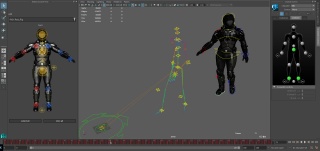
As a part of our bigger DCC pipeline right now we are concentrating on the part of the pipeline where all the cleaned/Uncleaned motion capture animation data could be transferred to our Maya DCC and to our Maya Puppet.
We’re building and designing many tools like character picker and animation binder which will make the animators work efficient. This is a first building block of our major pipeline where we are aiming animation sharing, transferring , character swapping and batch exporting. We are also scaling our character pipeline in a way which could be suitable to various departments.
Build
We’ve been working on trybuild, we have the waf now in for our game-dev branch. Once we move Transformer to use waf, trybuild can be enforced and which will be more efficient for builds, at least from a code point of view.
Been working on feature testing automation, still a few issues to iron out, mainly due to builds being made in ATX and tests running here in DE. It’s 90 % done. Chris Speak, our Senior QA, put together a simple feature test map against which I can easily run the py tool I wrote some time ago to drive the test.
Been helping the ATX guys who have been working on optimizing the assets job. In particular the idea is to break the huge assets job into smaller jobs, one per pak, that can then be assigned to multiple agents and run at the same time. This will also allow us to write our own paker instead of using RC for paking. All the above was sided by the usual troubleshooting, mainly due to a couple tools that went in recently and made their way into the build system
AI
A lot of progress for the FPS AI has been made in the last month.
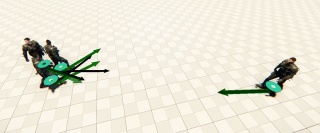
We have mostly been focusing on our first FPS combat scenario and we are iterating on the development of the behaviors of our first enemies. First of all we are completing our first pass on the combat from cover implementation: NPCs can now correctly select between the available shooting postures, selecting the best cover they can fight the players from and smoothly play animations to shoot from covers.
We created a Token system that will allow AI to coordinate their behavior decisions. As an example, imagine a group of NPCs in a situation where it would be really good to throw a grenade. The token system will the allow us to specify the amount of characters allowed to perform that action, that is achieved acquiring a “Throw Grenade” token that can be shared only between the specified n NPCs. This system is going to be used both for FPS and ships behavior, it is very useful for a lot of different type of coordination and we will share more with you as soon as we will have some concrete example in game.
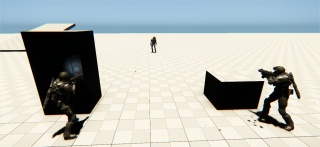
This month we also started working on character reciprocal collision avoidance integrating CryEngine ORCA implementation with our current movement code. We are planning to make some research on this topic, we want to have a couple of collision avoidance implementation to properly compare them and maybe use them in different scenarios.
Since last month we started iterating on the functionalities that will allow us to have multicrew ships fully controlled by the AI. We are working towards having specific crew members taking care of the different seats. That will allow us to have one NPC that can pilot the ship while the others can use the additional turrets to shoot. This is also the first step to allow in the future to have NPC crew members in a player-controlled ship!
In addition to all of that, the Frankfurt office is always continuing coordinating the work made by Moon Collider. This months that was mainly focused on spaceships formation, systemic take-off/landing, behavior improvements and a lot of optimizations and general improvements!
Design
On the design side this month there has been a lot of back and forth trying to unify the Power Distribution System for ships and stations and defining technical elements that need to get built for power piping to work. What we aim for is to have power management, for anything in the game, use the same systems, the same logic and the same UI elements. We do not want to have players learn a new system when they board a station. The visual part of the UI might be a bit different from one ship/station to another but ideally they should all work in the same way.
Life Support systems also have been going through a very similar process. We are looking towards having depressurisations affect players, AI and physicalized objects, dynamically creating breaches, having atmosphere compositions with a mix of benign or toxic gases and lots of ways in which these gasses will affect your normal gameplay and the environment around you.
On the FPS suit side of things we are taking a hard look at our inventory management. We’re trying to figure out how the player’s inventory will work while in first person, how do you loot, how do you change loadouts, how you reload weapons and all other activities that involve items the players might be carrying with them.
Todd has been writing up designs on new weapons, both ship mounted and for use in FPS, working closely with Toby, our Lead Weapon Artist, to make sure they fit in the existing manufacturer guidelines.
On the level design side, work is moving forward with the prototyping of modular environments, we will be using to build our procedurally generated stations, satellites etc. At the same time these building blocks are being used to create realistic looking levels to check their viability and make sure they don’t end up looking artificial and contrived. Ideally our aim is for the player to never be able to tell the difference between procedurally generated and hand crafted.
Level design also took on the task of prototyping a basic version of the Power Management System and all its components. This will allow us to drop it into an existing level and see how it plays out and what gameplay possibilities it opens and what problems it might cause even before we invest any coding time into it. Everything from consoles, generators to lightbulbs is being prototyped right now and hopefully soon we will have a clearer vision on how this will impact the game and how much of a change it will be.
The entire team, both systems and level design have been busy with a lot of interview work as we’ve got some very talented candidates and will be recruiting some really great guys & girls for the design team in Frankfurt.
VFX
The VFX team has recently been working on the EMP weapon for the Avenger Warlock variant. This has required considerable support from the coders in order to function how we intend. There are several action states the weapon goes through before it fires. Charging, fully charged, discharging, and detonation. All of these states had to be added by our coders and unique particle effects had to be created for each state. All of these things must work together seamlessly in order to bring the EMP to life!
Weapons
The weapon art team has been working on a new ship weapon, a Size 4 Ballistic Gatling Gun manufactured by Apocalypse Arms.
This will be the first ship weapon to use the Multi-Layer shader and serve as a gold standard for all future weapons to come.
MOON COLLIDER
We worked on some really cool features this month that we’re excited to share with you all. The big one was the addition of ship formations. This is a general purpose system that allows designers to define all kinds of group formations for ships to fly in, and then simply tell ships to join a formation. The AI will then take over and constantly adjust the ships as needed to keep the formation from then on.
A lot of work went into making formations robust and easy to use, and we think it will be a very powerful feature in the hands of the designers. They can control the system via flowgraph, with a simple node that lets them designate a ship as the leader and specify a formation pattern. Then, other ships can be told via another node to follow the leader, at which point Kythera assigns them to slots in the formation pattern that they will then try to keep up with until they’re told to stop flying in formation.
It was important that we didn’t end up with formations where the ships all look glued together and moving in perfect synchrony. However, that follows naturally because all the movements go through the same IFCS constraints as any other. The formation system calculates the ideal position for each following ship as an offset from wherever the lead ship currently is, and then each ship tries to reach its target point. Depending on the capabilities of each ship in the formation, some ships may struggle to keep up, particularly if the lead ship is doing aggressive maneuvers. This gives really nice results in practice because the following ships behave much like human controlled ships would in the same situation.
A great side effect of the way we implemented it is that formations can be used in controlled sequences when the lead ship is following a spline, or in dogfighting scenarios or other situations where the lead ship is using regular systemic behaviors.
We also allow following ships to deviate from the formation in order to avoid obstacles. So, for example, if the lead ship flies through an asteroid field, the following ships will break formation as needed to avoid collisions, and then reform again. This also means that designers don’t have to worry about whether a formation can neatly fit through some area, since the AI will just naturally do the right thing.
Another nice feature we added this month is the ability to trigger events when a ship reaches a certain point on a spline. Basically, designers now have the ability to name points on splines, and they can then set up their flowgraph to listen for when a ship reaches a point with a given name, and then trigger something cool. This is obviously really useful for having better control over scripted sequences, but it can also be really useful in other places such as dogfighting because it doesn’t have to be dependent on any specific spline. So, for example, we can now set up death spiral splines and name a point on all of them where we want to, say, trigger a nice explosion effect. We can then listen for this point to be reached, and it doesn’t matter which specific death spiral spline was chosen.
Finally, we’ve been making some improvements to our Inspector debugging tool, with a particular focus on streamlining the workflow when developing and iterating on AI behaviors. Normally, when working on behaviors, there is a constant cycle of editing the behavior, jumping into game to see how the change worked out, then tweaking the behavior based on the result. Thanks to the DataForge behavior tree editor we can now do this all without having to exit the game or recompile anything, but we saw some room to improve the workflow when using the Inspector to view the state of the behavior trees of characters or ships as the game is running.
One big time saver we added was better tracking in Inspector of what you were previously doing, such as which character or ship you were debugging. Then, even if you need to exit the game and make code changes for some reason, as soon as you jump back into game the Inspector will pick up right where you left off. When you’re doing dozens of iterations on behaviors the time saving can really add up!
Another improvement was to make it easier to find the parts of behavior trees that are currently executing. We now have really huge trees for character behaviors in particular, and this means that it can sometimes be hard to find which part of the tree the AI is currently running. So we’ve added in a new mode that zooms in on whichever part of the tree is currently active, allowing behavior designers to watch the tree live in one window and their game in another window and keep track of what is going on without having to pause all the time. These various time savings add up to faster behavior development, and that’s a win for all of us!
It’s been really satisfying to get these solid new features in, as we expect to be a little less involved over the next few months. We will be mainly focused on supporting the bugfixing effort for 2.0 as we head towards the holiday break. More significantly, as the internal AI team has ramped up in size this year they’ve been able to take on more of the front-line tasks, allowing Moon Collider to switch to more of a supporting role rather than leading development ourselves. In the new year we’ll continue supporting the AI team in helping to make Star Citizen bigger and better, but we’ll probably have fewer awesome new features to present in the monthly reports.
(Video missing)
Star Citizen: Formation Flying (Work-in-Progress) from Roberts Space Industries on Vimeo
BHVR
Greetings Citizen,
A lot of work is going on here at BHVR! Here’s what the different department are working on.
Design
First, we wrapped up the integration of the Million Mile High Club, polished the experience overall and fixed a few bugs to get it ready for release. We finished the whitebox for Nyx, it’s shops and their location. We integrated a few subscriber flair items that are going to be released later this year and beginning next year. We are also planning the next big collection of subscriber flair items. I cannot say much but it should be pretty cool. Working with ATX and UK, we ironed out the design for shopping and shopping interface in general, we are starting the work right now. Finally, we are overhauling the Revel & York hangar to welcome the Starfarer. Setting up shops and all theirs items is going to be a big chunk of work in the next few weeks. Stay tuned!
Art
This month we spent quite a good amount of time polishing and debugging Million Mile High Club map. It’s finally completed and we can’t wait to see what people think of it once is released.
We made big advancements on a new clothing store map. Mostly on the architectural assets and static props.
Finally, we revisited Levski, to do an art quality update and to finalise the map. Once again, we’ve been working hard on optimising the map, so we can have a solid performance when NPC and players will be walking around in the map.
Engineering
With the incoming Alpha-2.0.0 release, a good part of our development time has been spent on stabilization of the various new features that some of you might have had the chance to fiddle with on the PTU. As such, part of the team at Behaviour has been focusing on implementing the final few features and bug fixing for mobiGlas, the Elevator Terminal, Port Olisar’s Ship Spawning Terminal as well as the new Party System. We’ve also worked hand in hand with the UI Team from UK to integrate additional features to the user interface for the two new Multi-Crew ships that are part of this release, the Constellation and the Retaliator.
In addition to the usual support for the incoming release, we’ve also started to implement features that planned for later releases. As part of some incoming changes concerning the various ship components (weapons, items, etc), we’re doing a few minor tweaks to the current Holotable to make it a little more user friendly, with changes such as having specific visual language (color) on items as well as always displaying the name of items to make them more easy to identify. We’re also simultaneously working on making the Holotable accessible from the multiplayer Crusader which will allow ship loadouts to be customized more easily.
Finally, we’re just restarting to do some work on the planetside shopping experience. Part of the implementation mostly comes down to supporting the design team with new game objects & functionality that they can use to properly setup a physical shop on any location. At the same time, we’re also putting together a new version of the user interface. Once all of this is in place, we’ll be ready to plug in persistence into the system so that the shopping experience can be transported between different game sessions.
TURBULENT
Greetings from Montreal! Here’s what we’ve been up to in the last month:
AnniVERSEary Sale
November is always a fun month, since it marks the anniversary of the end of Star Citizen’s original funding campaign. In addition to the Livestream, there was an AnniVERSEary sale to thank members for their continued support and dedication to the project. Turbulent worked behind the scenes to provide the back-end support for those events, setting up all the ships in the store and related cross-chassis upgrades. For more details, check out the Ship Happens section below.
Pledge Buy Back
Remember the time when you had to make an agonizing decision to melt one of your favorite ships in order to buy the new Vanguard? Well, agonize no more! We have been working on a new feature called Pledge Buy Back, which allows you to “un-melt” a pledge. Although there will be a handful of pledges that are ineligible for Pledge Buy Back (for example: limited-item ships, physical merchandise), most of them will be. This new feature will be accessible via My Hangar. Coming soon!
Organization Invitations
The Star Citizen ‘verse is vast, and you can’t conquer it alone. That’s why you might consider joining an Organization. Currently, Organizations can send email invitations to prospective members via the RSI website. We are refreshing the look-and-feel of the invitation, to give more prominence to the Organization. Don’t worry, you’ll still find the RSI logo at the bottom, so you will know that the email came from our system.
Orgs 2.0
Speaking of Organizations, Turbulent and CIG are working together to plan and design the next component of what we refer to as “Orgs 2.0”. There are many modules that comprise the term, including microblogs and communication tools. We are determining which module will deliver the most “bang for the buck,” and laying out a roadmap for future modules.
Subscription Campaign
Subscribers are important cogs in the Star Citizen machine; thanks to their ongoing contributions, CIG are able to provide video series such as “Around the ‘Verse”, “10 for the Chairman”, “Bugsmashers” and other programs on a regular basis. We are currently refreshing the look-and-feel of the Subscribers section of the website, and reorganizing the information to make it easier to discover all the exclusive benefits you earn by being a Subscriber.
Bar Citizen
Toward the end of the month, some members of the Turbulent team had a chance to lunch with FlisherOfatale, head of the Quebec-based Organization called Les Gardiens du [LYS]. They are close to 200 members, and growing. It was great to chat about his in-game experiences, as well as pick his brain for feedback on the website and forum. At the end of the meal, he gave us some cool swag from his Org. Thanks, Flisher!
We were thrilled to learn what Mark Hamill’s character would be in the Squadron 42 story. His IMDB page is simply staggering; a veteran of movies and computer games, he will add a strong presence to the single-player campaign. Check out the Squadron 42 page on our website for his “bio” and portrait. Answer the call!
Ship Happens
This was an exciting month for Star Citizen, which saw the launch of many new ships and the sale of many existing ones. To kick off the Anniversary Livestream, 4 new ships were revealed. First, the Crucible, an adaptable repair ship to get damaged ships back up and running in no time, large and small. Next, the sister ship of the P-52 Merlin and the companion ship of the Constellation Phoenix, the P-72 Archimedes, which was designed to be a quick and agile fighter. Finally, there were the two new variants of the Avenger, each with their own specialization and distinct internal loadout. There was the Avenger Warlock, an electronic warfare focused ship with an EMP module to help fulfill its role. Then there was the Titan, which with its large, specialty module free internal bay, allows it to be a light cargo carrier with teeth. Each day, there was a different themed sale (e.g. Explorers, Pirates, Military, Aliens, etc.).The livestream was followed by a week and a half of daily themed anniversary sales, showcasing the various ship roles in the Star Citizen universe. These sales were capped off with a 5 day free-for-all sale, putting all ships previously available in the previous week and a half back up in the store.
Behind the Scenes
With all the excitement surrounding the AnniVERSEary, it was bound to have an impact on the website and pledge store. We expanded our server capacity and continuously monitored the website traffic and activity during the month. Fortunately, our infrastructure allows us to adjust capacity upward or downward as needed, so the cost impact was minimal.
We are also looking into what we can do for future versions of the Starmap to add even more depth and interactivity. We want to load it up with even more data for you to discover!
// END TRANSMISSION



